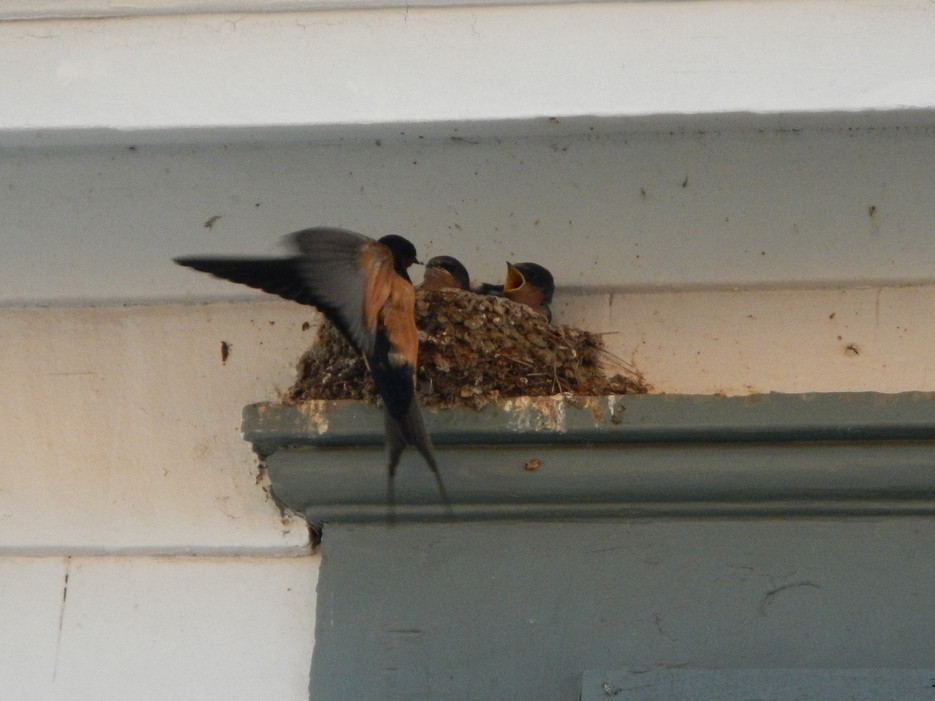How to Deter Swallows from Nesting Around your Business
At one time, barn swallows chose to build their mud nests on the underside of cliffs and caves. Now, however, not unlike many wild animals, the barn swallows have found that making their homes near humans on man-made structures is more ideal. Many barn swallows now build their nests in eaves, rafters, and cross beams on structures like barns, sheds, stables, bridges, and more. There can be many complications associated with barn swallows choosing to nest on your building.
Identifying a Barn Swallow
Barn swallows are a bright cobalt blue on the back and either a tawny if male or a white color if female on their underside. Barn swallows are distinct from other swallows by their long tail feathers that create a forked tail. Barn swallows make nests from scooping mud and grass together in pellets, and making cup-shaped nests lined with feathers. While the nests are generally built on man-made structures, swallows tend to choose buildings near open areas like fields, and preferably near water. Open areas allow them to catch the insects they eat. Swallows feed upon flies, wasps, bees, butterflies, ants, beetles, and other flying insects.
Potential Barn Swallow Problems
The largest problem you are probably experiencing with barn swallows on your building is their droppings. While cliff swallows tend to have a larger amount of damage as they tend to build colonies rather than a single nest like a barn swallow, barn swallows can still cause whitewashing or staining of building material due to their droppings. Droppings may also cause contamination of water or any animal feed that may be stored nearby. Barn swallows can also be very protective of their nests, and may swoop aggressively at anyone who comes near the nesting area. This can become a problem if the swallows choose to build their nests near business entrances, as they may swoop at your employees or any clients that may be visiting.
Federal Migratory Bird Act
At one time, barn swallows and other songbirds were killed for the use of their feathers on decorative hats. Although this practice is no longer allowed, in many areas the population is still on the decline at about 1% per year. As a result, the barn swallow has been placed under the protection of the Migratory Bird Treaty Act. Under this act, once an egg has been laid in the nest, the nest cannot be disturbed and must remain intact until the babies leave the nest. As a result, the best practice for solving a swallow problem is prevention.
Barn Swallow Migration
Barn swallows are found across North America but choose to migrate south to Central and South America during the colder months due to food availability. They arrive in early spring, as early as late January to early February, with peak migration in May. Eggs are usually laid in May and June, and from egg to baby, the nest can be occupied by the young for 44 to 58 days. Migration to the south usually occurs as early as mid-July but hits its peak in late August to early September.
Prevention Practices
Due to their protection, barn swallow prevention is best practiced before the swallows migrate back to your area and is the best way to get rid of barn swallows. Swallows are often attracted to previous nesting sites, so it is important that you remove any remaining nests. If possible, the area should also be disinfected to deter attraction to remaining scents of previous nestlings.
Placing physical barriers is usually the best practice for preventing barn swallows and cliff swallows from building nests on your structures. Netting made specifically for blocking birds, or other devices created for the purpose can be purchased and installed in problem areas. Installing alternative nesting places can also help deter nesting in unwanted areas. If you are still unsure about the best method for deterring barn swallows from nesting on your structures, consult a professional.
At Bird-B-Gone we make sure to hire professionals with knowledge about not only the creation of our products, but about the pest birds and their behavior patterns as well. If you are not sure where to begin, we can help you get started.

